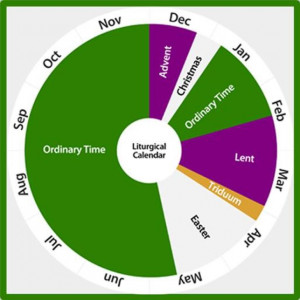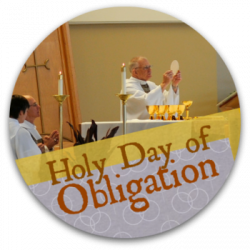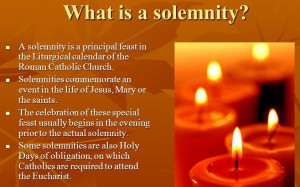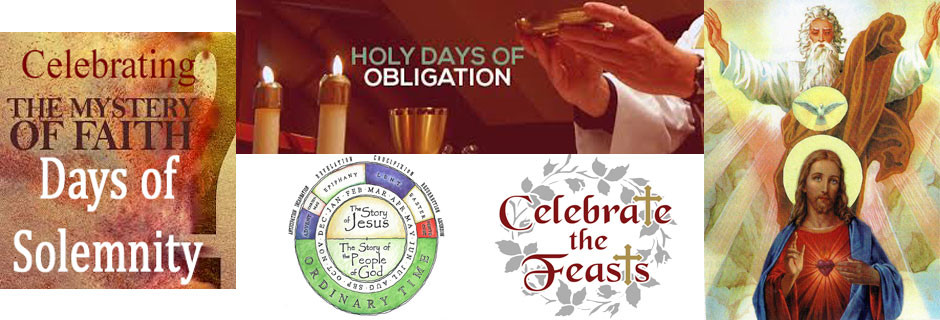
2020 Liturgical Season:
Jan. 13 – February 25, 2020: Ordinary Time
February 26 – May 31, 2020: Lent, Triduum, Easter
June 1 – November 28, 2020 – Ordinary Time
Nov. 29, 2020 – Jan. 10, 2021 – Advent, Christmas
Sundays (including Epiphany, Palm Sunday, Easter Sunday, Pentecost, etc.) are always obligatory or Holy Days of Obligation!
To grow in faith and holiness, in addition to the obligatory Sunday Mass and Holy Days of Obligation, discover the richness and beauty contained in the Church’s liturgical calendar. These holy days and solemnities are a great place to enrich your spiritual life! To ensure that you don’t forget these celebrations, note the dates on your calendar now and you’ll be prepared for the whole year!
2020 Holy Days of Obligation are indicated in italics.
Wednesday, January 1, 2020 – Solemnity of Mary, The Holy Mother of God, Holy Day of Obligation
Sunday, January 5, 2020 – Solemnity of the Epiphany of the Lord
Sunday, January 12, 2020 – The Baptism of the Lord
Wednesday, February 26, 2020 – Ash Wednesday
It is a common misconception that Ash Wednesday is a Holy Day of Obligation. However, it’s a great way to start the Lenten season!
Thursday, March 19, 2020 – Solemnity of Saint Joseph, Spouse of the Blessed Virgin Mary
Wednesday, March 25, 2020 – Solemnity of the Annunciation of the Lord
Sunday, April 5, 2020 – Palm Sunday of the Passion of the Lord
Thursday, April 9, 2020 – Holy Thursday
Friday, April 10, 2020 – Good Friday
Saturday, April 11, 2020 – Holy Saturday
Sunday, April 12, 2020 – Easter Sunday of the Resurrection of the Lord
Sunday, April 19, 2020 – Divine Mercy Sunday
Thursday, May 21, 2020 – Ascension of the Lord or Sunday, May 24, 2020 - Ascension of the Lord (Holy Day of Obligation) In several ecclesiastical provinces, the Ascension of the Lord is celebrated on Thursday. In the Los Angeles Archdiocese, the solemnity is celebrated on the following Sunday. When traveling, check with a local parish or diocese if you aren’t sure.
Sunday, May 31, 2020 – Pentecost
Sunday, June 7, 2020 – Solemnity of the Most Holy Trinity
Sunday, June 14, 2020 – Solemnity of the Most Holy Body and Blood of Christ (Corpus Christi)
Friday, June 19, 2020 – Solemnity of the Most Sacred Heart of Jesus
Wednesday, June 24, 2020 – Solemnity of the Nativity of Saint John the Baptist
Monday, June 29, 2020 – Solemnity of Saints Peter and Paul, Apostles
Saturday, August 15, 2020 – Solemnity of the Assumption of the Blessed Virgin Mary, Holy Day of Obligation
Sunday, November 1, 2020 – All Saints Day, Holy Day of Obligation
Monday, November 2, 2020 – The Commemoration of All the Faithful Departed (All Souls Day)
Sunday, November 22, 2020 – Solemnity of Our Lord Jesus Christ, King of the Universe (Christ the King)
Tuesday, December 8, 2020 – Solemnity of the Immaculate Conception of the Blessed Virgin Mary
Usually, a Holy Day of Obligation but is not in 2019. The USCCB explains, “Since December 8, 2019, is the Second Sunday of Advent, the Solemnity of the Immaculate Conception of the Blessed Virgin Mary is transferred to Monday, December 9, 2019. The obligation to attend Mass, however, does not transfer.”
Friday, December 25, 2020 – The Nativity of the Lord (Christmas), Holy Day of Obligation Click here for more information
More information on Holy Days of Obligation, Solemnities and Feast Days
 "The Church punctuates the liturgical year by celebrating various events important to the mystery of our salvation. During the course of the liturgical year, the Church celebrates the whole mystery of Christ, from His incarnation and birth to His ascension, to Pentecost and the founding of the Church, and finally to the second coming of Christ in judgment on the Solemnity of Christ the King. On Sundays in particular, we commemorate the Resurrection, when our Lord triumphed over sin and death. In a special way, the Church also honors our Blessed Mother, marking those special events of her participation in the mystery of salvation. Finally, the Church also commemorates the memorial days of saints, who through their lives bring to the minds of the faithful the call to holiness. Saints’ days are celebrated with few exceptions on the date of the saint’s death– their birth into eternal life.
"The Church punctuates the liturgical year by celebrating various events important to the mystery of our salvation. During the course of the liturgical year, the Church celebrates the whole mystery of Christ, from His incarnation and birth to His ascension, to Pentecost and the founding of the Church, and finally to the second coming of Christ in judgment on the Solemnity of Christ the King. On Sundays in particular, we commemorate the Resurrection, when our Lord triumphed over sin and death. In a special way, the Church also honors our Blessed Mother, marking those special events of her participation in the mystery of salvation. Finally, the Church also commemorates the memorial days of saints, who through their lives bring to the minds of the faithful the call to holiness. Saints’ days are celebrated with few exceptions on the date of the saint’s death– their birth into eternal life.
Technically, the divisions are as follows:
 Solemnities are the celebrations of greatest importance. Each Solemnity begins on the prior evening with first vespers (evening prayer) and several of the solemnities have their own Vigil Mass. On these days, both the Gloria and the Creed are recited. Sundays and Holy Days of Obligation (which in the United States are the Solemnity of Mary Mother of God, Ascension, Assumption, All Saints, Immaculate Conception, and Christmas) are always considered solemnities. Other examples of solemnities include the Solemnity of St. Joseph (March 19), the Solemnity of the Sacred Heart of Jesus (Friday after the Feast of Corpus Christi), and the Solemnity of St. Peter and St. Paul (June 29).
Solemnities are the celebrations of greatest importance. Each Solemnity begins on the prior evening with first vespers (evening prayer) and several of the solemnities have their own Vigil Mass. On these days, both the Gloria and the Creed are recited. Sundays and Holy Days of Obligation (which in the United States are the Solemnity of Mary Mother of God, Ascension, Assumption, All Saints, Immaculate Conception, and Christmas) are always considered solemnities. Other examples of solemnities include the Solemnity of St. Joseph (March 19), the Solemnity of the Sacred Heart of Jesus (Friday after the Feast of Corpus Christi), and the Solemnity of St. Peter and St. Paul (June 29).

 Feasts are of secondary importance in our liturgical calendar and are celebrated on a particular day. These feasts do not have a first vespers or Vigil Mass on the prior evening. An exception would be the feasts of the Lord which occur on Sundays in Ordinary Time and Sundays in the Christmas season. For example, the Feast of the Presentation of the Lord (February 2) has its own first vespers. On these days, the Gloria is recited but not the Creed.
Feasts are of secondary importance in our liturgical calendar and are celebrated on a particular day. These feasts do not have a first vespers or Vigil Mass on the prior evening. An exception would be the feasts of the Lord which occur on Sundays in Ordinary Time and Sundays in the Christmas season. For example, the Feast of the Presentation of the Lord (February 2) has its own first vespers. On these days, the Gloria is recited but not the Creed.
Next in line are memorials, which are classified as either obligatory or optional. Memorials commemorate a saint or saints. Obligatory memorials must be observed whereas optional memorials do not have to be observed. For example, the memorial of St. John Bosco (January 31) is obligatory while the memorial of St. Blase (February 3) is optional. Only the memorials of those saints who are of “universal significance” are observed by the whole Church and marked in the general liturgical calendar.
Particular churches, countries, or religious communities may also celebrate the memorials of other saints of “special significance” in accord with their special devotions. For example, the memorial in honor of the patron saint of a diocese is raised to a “feast.”
The celebration of memorials is also governed by the liturgical season. For instance, obligatory memorials occurring in Lent are only celebrated as optional memorials. During “Privileged Seasons” (December 17-31 and Lent) the prayer of the Saint may be substituted for the regular collect (opening prayer) of the Mass. During weekday Masses during Advent (prior to December 17), Christmas Season, Easter Season, and Ordinary Time, the priest may offer the Mass of the saint, or the Mass of any saint of the Roman Martyrology, or a Mass such as one for “Various Occasions” (e.g. Masses for the Spread of the Gospel or for Religious Vocations) or a Votive Mass (e.g. the Mass of St. Joseph or the Mass of the Angels). Also on Saturdays, when there is no obligatory memorial, it is most appropriate to offer the Mass of the Blessed Mother.
For complete details on the order of precedence, please consult the General Norms for the Liturgical Year and the New General Roman Calendar issued by Pope Paul VI in 1969. Nevertheless, the basic rule of thumb is this: Sundays, other Solemnities, Holy Week, and the Octave of Easter always take precedence. These are followed by Feasts, weekdays of Advent (December 17-24), days within the Octave of Christmas, weekdays of Lent, obligatory memorials, optional memorials, weekdays of Advent (through December 16), other weekdays of the Christmas Season, other weekdays of the Easter Season, and weekdays in Ordinary Time.
If reading this sequence seems a bit confusing, perhaps that is why the Bishop’s Committee on the Liturgy of the National Conference of Catholic Bishops publishes an annual Ordo which outlines the proper celebrations and their particulars throughout the liturgical year."

